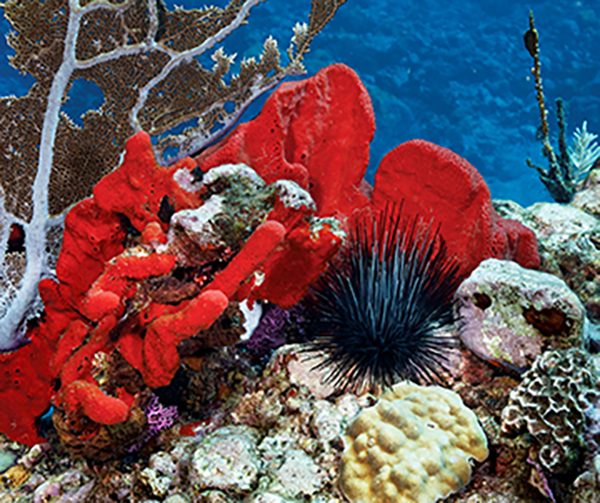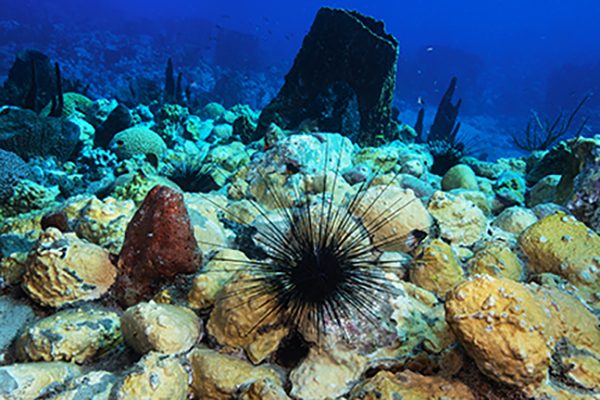Diadema Sea Urchin Loss
IN 1983-84, REEFS THROUGHOUT THE CARIBBEAN, FLORIDA, AND BERMUDA experienced one of the greatest mass mortalities of a marine species ever recorded when an unknown waterborne pathogen killed more than 98 percent of the Diadema sea urchin population.1 In February of this year, divers in St. Thomas noticed many of the Diadema were suddenly no longer attached to the substrate, began losing their spines, and were dead within a day or so of these observations. Since then, divers have seen Diadema urchins suffer the same fate elsewhere in the Caribbean. Is history repeating itself, and is there anything we can do?
WHY DO WE CARE
ABOUT AN URCHIN?
While divers might not be pulling their cameras out for an urchin, this particular urchin is essential for helping maintain an ecological balance between algae and corals. Easily recognized by its long spines relative to its body, Diadema antillarum, also known as the long-spined sea urchin, is a keystone Caribbean reef herbivore that feeds on many of the algae that compete for space with corals on reefs. With the expected increase in algal cover following the current Diadema mortality event, a corresponding decrease in “bare” limestone and crustose coralline algae — necessary substrates for coral larvae to settle and survive — is anticipated.2 The 1980s Diadema loss helped cause a shift in ecosystem dominance from stony corals to algae that has occurred on many Caribbean and Florida reefs.3
Diadema recovery during the past four decades has varied widely throughout the region. In areas where the Diadema population has increased, a decrease in macroalgae and an increase in coral cover further reinforce this herbivore’s importance in nature.4
As marine biologist Judith Lang, PhD, of the Atlantic and Gulf Rapid Reef Assessment Program stated, “A population of healthy Diadema is crucial, but not in itself sufficient, to compensate for the warming temperatures, ocean acidification, overfishing, and coral diseases that collectively endanger these reefs.”
WHAT IS GOING ON NOW?
By March, there were additional reports of mass mortalities. At this point (early July) the eastern and much of the northern Caribbean has been affected, and there have been some reports of sick or dying urchins on northern Florida Keys and Biscayne Bay reefs as well.5
Alwin Hylkema described the symptoms in detail during a presentation on April 5, 2022, at the Dutch Caribbean Nature Alliance Diadema Restoration Workshop on Saba. The urchins lose control of their tube feet and detach from the substrate or leave their crevices to land on the seafloor. Then the spines move slowly and even droop before they start falling off, and the urchins often have a pile of spines lying on the ground next to them. Within two days of the initial observation of a sick urchin, it is dead.
Hylkema further explained that whatever affects the urchins in the Caribbean is waterborne because urchins in his labs were infected when he used local sea water in their tanks. Larvae were unaffected; however, the causative agent quickly spreads through the adult population. At one site on Saba, there was 95 percent mortality within three weeks. These observations match what happened in 1983-84.
There are some notable differences from the 1980s infection event. Lang explained that the die-off in the 1980s had traveled via known ocean currents and countercurrents from where it was first observed in Panama, taking 13 months to get through the Caribbean and Florida to Bermuda. About the spread in spring 2022, Lang said, “Although it has since slowed down, the speed at which different areas became infected in March and April, and their seemingly random geographic distribution, are completely different from what happened in the 80s.” Hylkema suggested that ballast or bilge water might have helped spread the disease from island to island. Simon Walsh, a dive shop owner in Dominica, explained it was notably odd that the urchins in both the northern and southern ends of the island were experiencing the mortality event at the same time.6
Walsh initially thought he was seeing “complete devastation” when urchins started dying in March, and populations across his dive sites succumbed over the following months. By May, he started seeing more small, juvenile urchins, particularly in shallow waters, giving hope that this mass mortality event won’t lead to the same consequences we had before.
WHAT IS BEING DONE?
The mortality event initially reported in February precipitated immediate emergency responses in the U.S. Virgin Islands and Puerto Rico. Once it became more widespread, scientists, dive shops, governmental agencies, universities, and recreational divers throughout the Caribbean and Florida quickly teamed up to gain as much information as possible. By late March, a collaborative region-wide effort called the Diadema Response Network was in place (agrra.org/sea-urchin-die-off/).
Scientists are currently working to determine the cause of death for this mortality event by examining tissue samples of healthy or diseased Diadema in collections from Grenada to Florida and Mexico that diverse groups of managers, biologists, environmentalists, students, or other volunteers have contributed. Other local efforts have included outreach posters, educational offerings in the major languages of the Caribbean, and a bilingual, regionally focused webinar in May, in which Stacey Williams of the Institute for Socio-Ecological Research presented different Diadema restoration strategies. Bill Sharp of the Florida Fish and Wildlife Conservation Commission explained that while there have been some confirmed observations of urchins with symptoms like those in the Caribbean, they are waiting for histological analysis results before drawing conclusions about the cause of death. In the meantime, Florida teams closely monitor Diadema populations throughout the reef tract.
WHAT CAN THE RECREATIONAL
DIVER DO TO HELP?
The Diadema Response Team developed a website where anyone can report observations of any dead, sick, or alive Diadema, along with the location, dive site details, and photos. You can report observations at survey123.arcgis.com/share/7879b018f20f4602ad82c24c4e0d1e98.
Since the causative agent for the mortality event is likely waterborne, be aware that pathogens can survive on dive gear. You should decontaminate your gear from one site to the next or rent gear locally if possible. As there are still so many unknowns, it is best to assume that whatever is killing the urchins can spread through contact — be mindful of buoyancy and don’t touch the urchins. But if you see one, please pause to marvel about the importance of its role in nature.
Keep diving and supporting the Caribbean and Florida reefs and dive shops. Many shops actively engage in conservation-based activities such as coral restoration, treating corals infected with stony coral tissue loss disease, monitoring Diadema populations, and partnering with governmental agencies, universities, and other organizations on various research projects. By supporting dive shops, you indirectly assist with much-needed coral reef conservation efforts. AD
References
- Lessios HA. The great Diadema antillarum die-off: 30 years later. Annual Review of Marine Science 2016; 8:267–283.
- Hylkema A, Debrot AO, Pistor M, Postma E, Williams SM, Kitson-Walters K. High peak settlement of Diadema antillarum on different artificial collectors in the Eastern Caribbean. Journal of Experimental Marine Biology and Ecology 2022; 549:159693.
- Jackson JBC, Donovan MK, Cramer KL, Lam VV, eds. Status and Trends of Caribbean Coral Reefs: 1970–2012. IUCN Global Coral Reef Monitoring Network, Gland, Switzerland; 2014:304. doi:10.13140/2.1.4868.6726
- Idjadi JA, Haring RN, Precht WF. Recovery of the sea urchin Diadema antillarum promotes scleractinian coral growth and survivorship on shallow Jamaican reefs. Mar. Ecol. Prog. Ser., 2010; 403:91-100.
Mudge L, Alves C, Figueroa-Zavala B, Bruno J. Assessment of elkhorn coral populations and associated herbivores in Akumal, Mexico. Front. Mar. Sci., 2019; 12. - Lang J. Tracking Diadema Health. Diadema Response Network. www.agrra.org/sea-urchin-die-off/. Accessed June 25, 2022.
William Sharp, interview by Sarah Egner, June 18, 2022. - Simon Walsh, interview by Sarah Egner, June 13, 2022.


Both photos are from the Eastern Caribbean — on the left from St. Lucia and on the right from Dominica. Notably, the seafloor surrounding the sea urchins is nearly devoid of algae. Diadema urchins graze on the algae and enhance the health of the coral reef. Following their demise in the 1980s, algae began to overtake the coral reef.
…
this particular urchin is essential for helping maintain an ecological balance between algae and corals.
© Alert Diver — Q3 2022